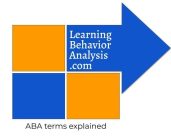I-4: Train personnel to competently perform assessment and intervention procedures. ©
Important note: Fictionalized clients are used to demonstrate the skill items in the second half of the task list, sections F-I. They make the most sense when read in order. Please remember that there is not substitute for real-life supervision and consultation. Get your case-specific advice from professionals – not from the internet! These examples are just that – examples of how behavior analytic skills might be applied.
Want this as a downloadable PDF? Click here!
Jada

Case example: Jada is an elementary school student. She experiences Level 3 Autism Spectrum Disorder (ASD). Level 3 is the severity level of Autism which is characterized by “requiring very substantial support.” Jada has also been diagnosed with a severe Intellectual Disability (ID). Jada has just transferred to a private school for individuals with global needs. She loves all kinds of play and messy activities, such as finger paint and water play. She also enjoys swinging on the playground, eating popcorn, and watching Disney movies. She loves to be read to, and laughs when staff make dramatic gestures while reading picture books. Jada does not use any vocal speech. She makes noises sometimes, such as humming. Jada engages in motor stimming, including upper body tensing and flapping her arms. Jada engages in severe challenging behavior, including self injury (hand to head and head to surface) and aggression (including hitting and biting). Jada has a mom, dad, and older brother living together in one home. Jada’s family has advocated for her to attend a private program, and they are excited for her to get high quality services. Jada’s new behavior analyst is Dr. Brown-Davis, who is a BCBA-D employed by the private program.
Example of Item I-4: Dr. Brown-Davis uses Behavioral Skills Training (BST) to train or re-train staff on new skills. BST is an empirically validated way to conduct active, competency-based training sessions. First, Dr. Brown-Davis explains the reason for the skill (rationale), and provides an observable and measurable description of what it looks like to have achieved competency/mastery of the skill. He then models the skill for staff, in real life if possible, or using role-play in a contrived scenario. Trainees are then invited to practice the skill. Dr. Brown-Davis provides immediate praise and constructive feedback as needed. Practice and feedback continues until mastery has been achieved.
Donovan

Case example: Donovan is a high school student. He has been diagnosed with Attention Deficit Hyperactivity Disorder (ADHD) and Oppositional Defiant Disorder (ODD). He attends a public school and has been placed in a support program for students with social/emotional/behavioral needs. Donovan enjoys playing video games and drawing in his sketchbook. He would like to be a welder when he is an adult. Academic achievement and attendance have been challenges for Donovan historically, and he is currently not on track to graduate with his peers due to missed work and failing grades in several classes. Donovan’s team has identified challenges including frequent non-attendance to school, walking the halls during class times, non-attendance at expected guidance appointments, and non-completion of classwork. Donovan lives with his mother and older brother. Donovan’s mother is concerned about her son’s school challenges and expresses frustration about his “lack of commitment” to his education. She wants Donovan to understand how important it is to graduate from high school. Donovan’s behavior analyst is Ms. Bailey, who has just started contracting with Donovan’s school district through the agency she works for.
Example of Item I-4: Ms. Bailey uses Behavioral Skills Training (BST) to train or re-train staff on new skills. She uses BST methodology to guide her skills instruction when she works with Mandy, her new clinical supervisee, and when working with school staff receiving consultation (including Donovan’s teachers). Ms. Bailey even uses BST to teach skills to clients directly, when appropriate. BST is an empirically validated way to conduct active, competency-based training sessions. First, Ms. Bailey explains the reason for the skill (rationale), and provides an observable and measurable description of what it looks like to have achieved competency/mastery of the skill. She then models the skill for staff, in real life if possible, or using role-play in a contrived scenario. Trainees are then invited to practice the skill. Ms. Bailey provides immediate praise and constructive feedback as needed. Practice and feedback continues until mastery has been achieved.
